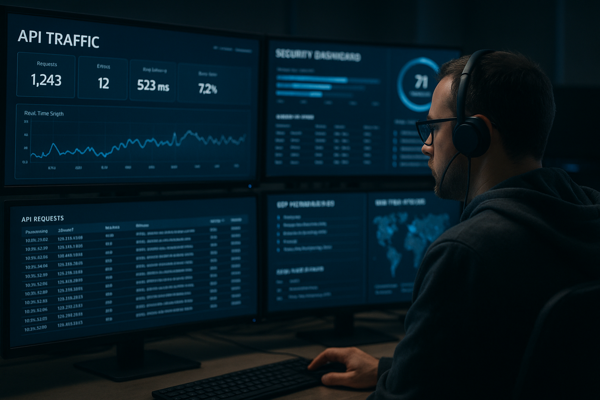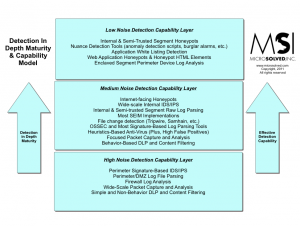As APIs now power over half of global internet traffic, they have become prime real estate for cyberattacks. While their agility and integration potential fuel innovation, they also multiply exposure points for malicious actors. It’s no surprise that API abuse ranks high in the OWASP threat landscape. Yet, in many environments, API security remains immature, fragmented, or overly reactive. Drawing from the latest research and implementation playbooks, this post explores a comprehensive and modernized approach to API threat detection and response, rooted in pragmatic security engineering and continuous evolution.

The Blind Spots We Keep Missing
Even among security-mature organizations, API environments often suffer from critical blind spots:
- Shadow APIs – These are endpoints deployed outside formal pipelines, such as by development teams working on rapid prototypes or internal tools. They escape traditional discovery mechanisms and logging, leaving attackers with forgotten doors to exploit. In one real-world breach, an old version of an authentication API exposed sensitive user details because it wasn’t removed after a system upgrade.
- No Continuous Discovery – As DevOps speeds up release cycles, static API inventories quickly become obsolete. Without tools that automatically discover new or modified endpoints, organizations can’t monitor what they don’t know exists.
- Lack of Behavioral Analysis – Many organizations still rely on traditional signature-based detection, which misses sophisticated threats like “low and slow” enumeration attacks. These involve attackers making small, seemingly benign requests over long periods to map the API’s structure.
- Token Reuse & Abuse – Tokens used across multiple devices or geographic regions can indicate session hijacking or replay attacks. Without logging and correlating token usage, these patterns remain invisible.
- Rate Limit Workarounds – Attackers often use distributed networks or timed intervals to fly under static rate-limiting thresholds. API scraping bots, for example, simulate human interaction rates to avoid detection.
Defenders: You’re Sitting on Untapped Gold
For many defenders, SIEM and XDR platforms are underutilized in the API realm. Yet these platforms offer enormous untapped potential:
- Cross-Surface Correlation – An authentication anomaly in API traffic could correlate with malware detection on a related endpoint. For instance, failed logins followed by a token request and an unusual download from a user’s laptop might reveal a compromised account used for exfiltration.
- Token Lifecycle Analytics – By tracking token issuance, usage frequency, IP variance, and expiry patterns, defenders can identify misuse, such as tokens repeatedly used seconds before expiration or from IPs in different countries.
- Behavioral Baselines – A typical user might access the API twice daily from the same IP. When that pattern changes—say, 100 requests from 5 IPs overnight—it’s a strong anomaly signal.
- Anomaly-Driven Alerting – Instead of relying only on known indicators of compromise, defenders can leverage behavioral models to identify new threats. A sudden surge in API calls at 3 AM may not break thresholds but should trigger alerts when contextualized.
Build the Foundation Before You Scale
Start simple, but start smart:
1. Inventory Everything – Use API gateways, WAF logs, and network taps to discover both documented and shadow APIs. Automate this discovery to keep pace with change.
2. Log the Essentials – Capture detailed logs including timestamps, methods, endpoints, source IPs, tokens, user agents, and status codes. Ensure these are parsed and structured for analytics.
3. Integrate with SIEM/XDR – Normalize API logs into your central platforms. Begin with the API gateway, then extend to application and infrastructure levels.
Then evolve:
Deploy rule-based detections for common attack patterns like:
- Failed Logins: 10+ 401s from a single IP within 5 minutes.
- Enumeration: 50+ 404s or unique endpoint requests from one source.
- Token Sharing: Same token used by multiple user agents or IPs.
- Rate Abuse: More than 100 requests per minute by a non-service account.
Enrich logs with context—geo-IP mapping, threat intel indicators, user identity data—to reduce false positives and prioritize incidents.
Add anomaly detection tools that learn normal patterns and alert on deviations, such as late-night admin access or unusual API method usage.
The Automation Opportunity
API defense demands speed. Automation isn’t a luxury—it’s survival:
- Rate Limiting Enforcement that adapts dynamically. For example, if a new user triggers excessive token refreshes in a short window, their limit can be temporarily reduced without affecting other users.
- Token Revocation that is triggered when a token is seen accessing multiple endpoints from different countries within a short timeframe.
- Alert Enrichment & Routing that generates incident tickets with user context, session data, and recent activity timelines automatically appended.
- IP Blocking or Throttling activated instantly when behaviors match known scraping or SSRF patterns, such as access to internal metadata IPs.
And in the near future, we’ll see predictive detection, where machine learning models identify suspicious behavior even before it crosses thresholds, enabling preemptive mitigation actions.
When an incident hits, a mature API response process looks like this:
- Detection – Alerts trigger via correlation rules (e.g., multiple failed logins followed by a success) or anomaly engines flagging strange behavior (e.g., sudden geographic shift).
- Containment – Block malicious IPs, disable compromised tokens, throttle affected endpoints, and engage emergency rate limits. Example: If a developer token is hijacked and starts mass-exporting data, it can be instantly revoked while the associated endpoints are rate-limited.
- Investigation – Correlate API logs with endpoint and network data. Identify the initial compromise vector, such as an exposed endpoint or insecure token handling in a mobile app.
- Recovery – Patch vulnerabilities, rotate secrets, and revalidate service integrity. Validate logs and backups for signs of tampering.
- Post-Mortem – Review gaps, update detection rules, run simulations based on attack patterns, and refine playbooks. For example, create a new rule to flag token use from IPs with past abuse history.
Metrics That Matter
You can’t improve what you don’t measure. Monitor these key metrics:
- Authentication Failure Rate – Surges can highlight brute force attempts or credential stuffing.
- Rate Limit Violations – How often thresholds are exceeded can point to scraping or misconfigured clients.
- Mean Time to Detect (MTTD) and Mean Time to Respond (MTTR) – Benchmark how quickly threats are identified and mitigated.
- Token Misuse Frequency – Number of sessions showing token reuse anomalies.
- API Detection Rule Coverage – Track how many OWASP API Top 10 threats are actively monitored.
- False Positive Rate – High rates may degrade trust and response quality.
- Availability During Incidents – Measure uptime impact of security responses.
- Rule Tuning Post-Incident – How often detection logic is improved following incidents.
Final Word: The Threat is Evolving—So Must We
The state of API security is rapidly shifting. Attackers aren’t waiting. Neither can we. By investing in foundational visibility, behavioral intelligence, and response automation, organizations can reclaim the upper hand.
It’s not just about plugging holes—it’s about anticipating them. With the right strategy, tools, and mindset, defenders can stay ahead of the curve and turn their API infrastructure from a liability into a defensive asset.
Let this be your call to action.
More Info and Assistance by Leveraging MicroSolved’s Expertise
Call us (+1.614.351.1237) or drop us a line (info@microsolved.com) for a no-hassle discussion of these best practices, implementation or optimization help, or an assessment of your current capabilities. We look forward to putting our decades of experience to work for you!
* AI tools were used as a research assistant for this content, but human moderation and writing are also included. The included images are AI-generated.



